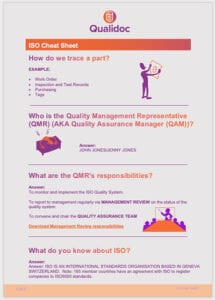Creating a Master Document List (MDL)
One of the main tasks in developing a formal quality system is to create an MDL that will record, in hard copy or electronically, all the documents involved — from contract review to final delivery of the product, with the revision status.
It is never too early to establish the following:
- Who will control the list? (Preferably limited to one authorized individual, usually the Quality Management Representative (QMR)).
- Who will have authorized access for review, revision and amendment? (Usually the QMR, but in larger companies it could be the technical library or engineering staff authorized person.)
- Who should be considered when compiling the list of “authorized, responsible individuals”? (Identify any persons responsible for review and release. Circulate their names and responsibilities to those with authority and responsibility for signing off design development and other critical processes).
- Is there a Signatories List to safeguard against, and identify, the squiggles that some people use as signatures?
- Are documents verified thoroughly before issue, including content, a logical sequence of events with the reader in mind, grammar and spelling? (No wandering apostrophes and misplaced commas!).
Digital (electronic records)
Verify that:
- signatures are limited to authorised persons,
- signatures are validated against a Signatories List to ensure accuracy, reliability and consistency,
- records are protected to enable ready retrieval throughout the retention period (MASTER DOCUMENT LIST),
- secure, computer-generated, time-stamped audit trails are used to independently record the date and time of operator entries and actions, particularly those that create, modify or delete electronic records,
- changes to records do not obscure previously recorded information,
- audit trail documentation is retained for at least the time required by IMH Documentation Requirements procedures,
- persons who develop, maintain or use electronic record/electronic signatures have the education, training and experience to perform their assigned tasks,
- documents are written clearly with the reader in mind.
Consider also:
• Where do the documents begin to appear in the design and production process?
• Do they include user documents?
• What is the distribution (see Signatories List) (Please, no uncontrolled copies!)
• What are the connecting authorities and responsibilities for each document? (Who needs to know? Include external authorities where applicable)
• Where will hard copy documents be kept? (Secure from damage or other deterioration such as climate, for example):
| Customer Service Documentation: |
| Purchase Orders Administration Department |
| Completed Jobs |
| Contracts XYZ Computer System |
| Quotations |
| I.M.Happy IM&TE Records Quality Assurance Department |
| Quality Assurance Documentation: |
| Quality Policy and Procedures Manuals (Master) Quality Assurance Dept |
| Audit Documentation (Master Copies) |
| Training Records HR Department |
| Personnel Files |
| Regulatory Files |
| Service Manuals Operations Department |
| Proprietary Documents CEO’S/Finance Director’s Office |
• Who will be in charge of the documents at the point of use?
• Has documentation development been included in the quality plan and management quality objectives?
You may be under the impression that the above concerns are known and understood by all senior company executives, who govern themselves accordingly; unfortunately, they do not. I have seen files of critical documents stored in the most lamentable conditions, subject to the onslaught of seagulls. This is less likely to happen nowadays, with documents stored electronically. Many companies, however, simply update documents and put the latest version online at prescribed (or ad hoc) intervals, consigning previous versions to the waste basket. The history and revision trail of the document can be preserved if the previous revisions have been exported to another authorized individual within the company, but this process can weaken the security of documents. Revision status is critical for the smooth running of the processes.
As well as all the above preparations and TLC, I would like to think that you are paying close attention to the style and content of the documents. Clarity is essential; try to stay away from “management speak” and other faddy language that can clutter the best thought-out and well-intentioned policies and procedures.
Start the document control process in small, manageable pieces. Remember to assign the relevant authorities and responsibilities at the earliest possible stage in the project. Nothing will create more confusion than a last-minute attempt to assess and categorise documents. Document control can be a major embarrassment in certification assessment; it can also hamper day-to-day activities if neglected.
You don’t want this to happen in your company, do you?
